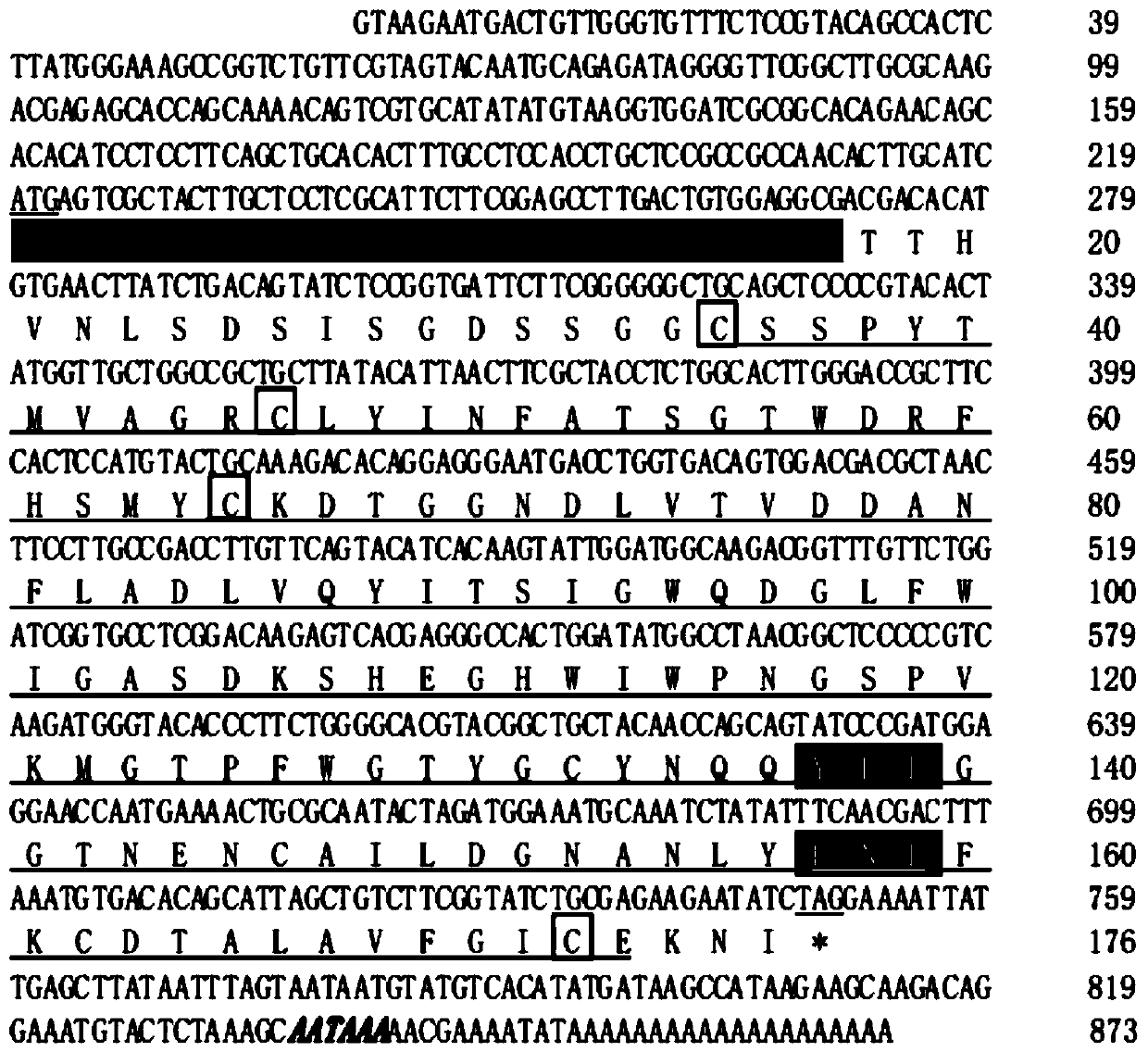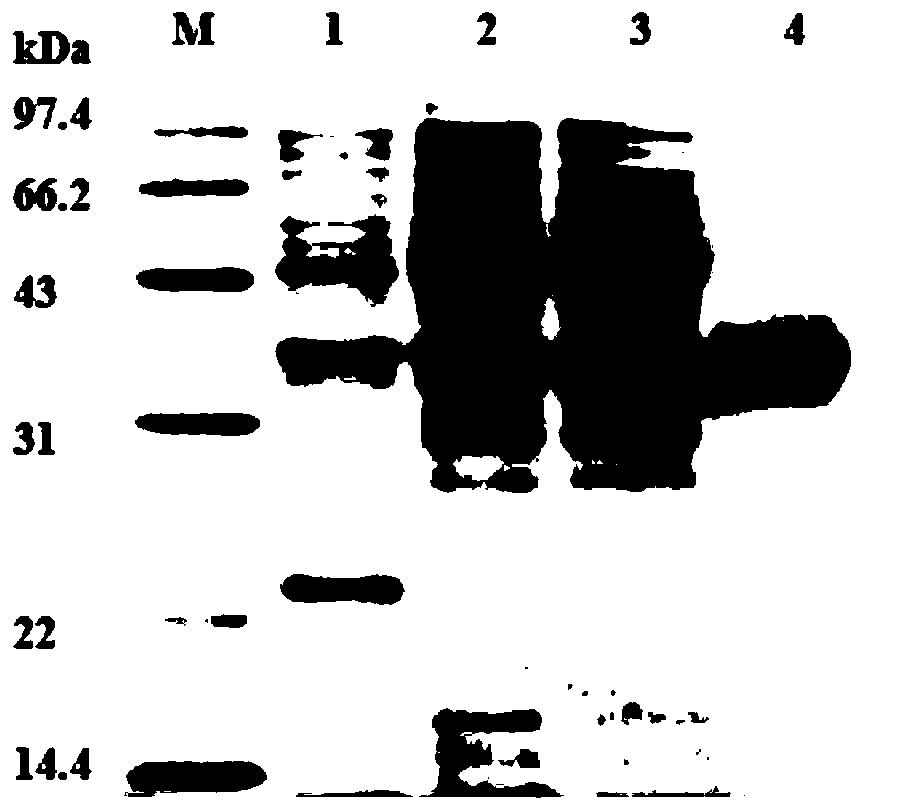C-type lectin PtCLec1 gene of portunus trituberculatus and encoded protein and application thereof
A technology of Portunus trituberculatus and gene encoding, which is applied in the field of molecular biology and can solve problems such as unclear influence of gene function
- Summary
- Abstract
- Description
- Claims
- Application Information
AI Technical Summary
Problems solved by technology
Method used
Image
Examples
Embodiment 1
[0029] The C-type lectin PtCLec1 gene of Portunus trituberculatus has the base sequence shown in SEQ ID No.1.
[0030] Depend on figure 1 It can be seen that the sequence table SEQ ID No.1 is:
[0031] GTAAGAATGACTGTTGGGTGTTTCTCCGTACAGCCACTCTTATGGGAAAGCCGGTCTGTTCGTAGTACAATGCAGAGATAGGGGTTCGGCTTGCGCAAGACGAGAGCACCAGCAAAACAGTCGTGCATATATGTAAGGTGGATCGCGGCACAGAACAGCACACATCCTCCTTCAGCTGCACACTTTGCCTCCACCTGCTCCGCCGCCAACACTTGCATCATGAGTCGCTACTTGCTCCTCGCATTCTTCGGAGCCTTGACTGTGGAGGCGACGACACATGTGAACTTATCTGACAGTATCTCCGGTGATTCTTCGGGGGGCTGCAGCTCCCCGTACACTATGGTTGCTGGCCGCTGCTTATACATTAACTTCGCTACCTCTGGCACTTGGGACCGCTTCCACTCCATGTACTGCAAAGACACAGGAGGGAATGACCTGGTGACAGTGGACGACGCTAACTTCCTTGCCGACCTTGTTCAGTACATCACAAGTATTGGATGGCAAGACGGTTTGTTCTGGATCGGTGCCTCGGACAAGAGTCACGAGGGCCACTGGATATGGCCTAACGGCTCCCCCGTCAAGATGGGTACACCCTTCTGGGGCACGTACGGCTGCTACAACCAGCAGTATCCCGATGGAGGAACCAATGAAAACTGCGCAATACTAGATGGAAATGCAAATCTATATTTCAACGACTTTAAATGTGACACAGCATTAGCTGTCTTCGGTATCTGCGAGAAGAATATCTAGGAAAATTATTGAGCTTATAATTTAGTAATAATGTATGTCA...
Embodiment 2
[0063] The base sequence of the C-type lectin of Portunus trituberculatus is described in SEQ ID No. 1 in the sequence table, and the amino acid sequence is described in SEQ ID No. 2 in the sequence table.
[0064] The sequence listing SEQ ID No.2 is:
[0065] MSRYLLLAFFGALTVEATTHVNLSDSISGDSSGGCSSPYTMVAGRCLYINFATSGTWDRFHSMYCKDTGGNDLVTVDDANFLADLVQYITSIGWQDGLFWIGASDKSHEGHWIWPNGSPVKMGTPFWGTYGCYNQQYPDGGTNENCAILDGNANLYFNDFKCDTALAVFGICEKNI
[0066] It has a complete coded protein containing 176 amino acids, the coded sequence has a signal peptide (1-17), the predicted molecular weight is 19.285kDa, and the isoelectric point is 4.45. The mature peptide contains 159 amino acids with a typical CRD domain (35-173), which contains 4 cysteine residues capable of forming two disulfide bonds. The CRD domain lacks the typical vertebrate and invertebrate mannose-recognizing motif EPN (Glu-Pro-Asn), but contains an unusual YPD motif (Tyr-Pro-Asp), which may It is mutated from the QPD (Gln-...
Embodiment 3
[0070] 1. In vitro antibacterial test of the C-type lectin PtCLec1 recombinant protein of Portunus trituberculatus:
[0071] Culture and preparation of microorganisms: Vibrio alginolyticus was cultured in TSB medium at 28°C, Vibrio parahaemolyticus was cultured in TSB medium at 28°C, Pseudomonas aeruginosa was cultured in TSB medium at 37°C, Staphylococcus aureus was cultured in LB Base cultured at 37°C, Micrococcus luteus cultured at 37°C with LB medium, Pichia pastoris with YPD medium at 28°C, and the above-mentioned strains were cultured on a shaker at 220rpm / min to make the bacterial concentration reach the logarithmic growth phase, respectively. 50mM Tris-HCl (pH=8.0) buffer solution dilutes the bacterium so that the number of colonies per milliliter of the bacterium solution is about 1×10 3 indivual.
PUM
| Property | Measurement | Unit |
|---|---|---|
| Molecular weight | aaaaa | aaaaa |
Abstract
Description
Claims
Application Information
 Login to View More
Login to View More - R&D
- Intellectual Property
- Life Sciences
- Materials
- Tech Scout
- Unparalleled Data Quality
- Higher Quality Content
- 60% Fewer Hallucinations
Browse by: Latest US Patents, China's latest patents, Technical Efficacy Thesaurus, Application Domain, Technology Topic, Popular Technical Reports.
© 2025 PatSnap. All rights reserved.Legal|Privacy policy|Modern Slavery Act Transparency Statement|Sitemap|About US| Contact US: help@patsnap.com



